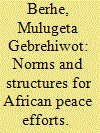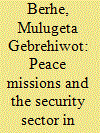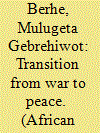| Srl | Item |
| 1 |
ID:
154378


|
|
|
|
|
| Summary/Abstract |
This article aims to chronicle and analyse the transformation of the army of the Ethiopian People’s Revolutionary Democratic Front (EPRDF) into a national army following its military and political triumph in 1991. The history of a modern army in Ethiopia is recent, beginning with the end of the Second World War. Since then, the Ethiopian army has gone through major changes under different regimes. However, it is only the latest version of the national army that has a properly organised military doctrine and strategy. Prior to this, the army’s concept of operations was shaped by the doctrines and strategies of its foreign sponsors. The organisation of the imperial army was influenced by the doctrine and strategy of Western armies (initially the British and later the Americans); the army’s concept of operations during the military regime was shaped by Soviet senior military advisors. The EPRDF army was an insurgent army that developed into a conventional army with its own set of military and military–political institutions, including its own military doctrine and its own concept of the science and art of war. The transition of the EPRDF army into a national army is a unique example of restructuring a people’s army into a national military, something rarely if ever attempted with this kind of comprehensiveness.
|
|
|
|
|
|
|
|
|
|
|
|
|
|
|
|
| 2 |
ID:
153696


|
|
|
|
|
| Summary/Abstract |
The African Peace and Security Architecture (APSA) is a set of norms and structures developed and designed to enable Africa with its peace and security affairs. It is an important instrument that enabled Africa gain significant success in its efforts to promote stability in Africa. The APSA was designed in the early 2000s and Africa needs to fully implement its norms and fully utilize its instruments. There is also a need to address gaps and redundancies so that it fits to the current context of new internal and global challenges.
|
|
|
|
|
|
|
|
|
|
|
|
|
|
|
|
| 3 |
ID:
154374


|
|
|
| 4 |
ID:
154377


|
|
|
|
|
| Summary/Abstract |
The objective of this paper is to chronicle the 1991 to 1997 Ethiopian disarmament, demobilisation and reintegration (DDR) experience in the context of Ethiopia’s transition from war to peace. The DDR project is usually a post-conflict political project that should be analysed in the overall context of transition from war to peace. The literature on the Ethiopian experience is focused on the technical aspects of the programme and the assessment of its impacts, with little to no attempts made to capture the experience in the context of Ethiopia’s transition from war to peace. Given that there are many existing and several incoming post-conflict countries, capturing the successful Ethiopian DDR experience is important, as some aspects will inform the design of ongoing and upcoming transitions from war to peace. This paper illustrates the wider challenges of the transition from war to peace as a context for the DDR programme, delves into the key strategies and elements of the programme, and summarises its impact assessment. In the conclusion, the key lessons to be learned from the experience are laid out.
|
|
|
|
|
|
|
|
|
|
|
|
|
|
|
|